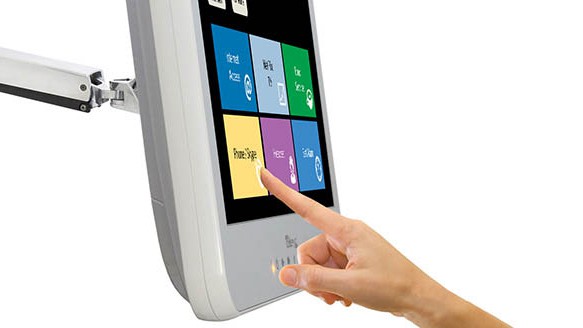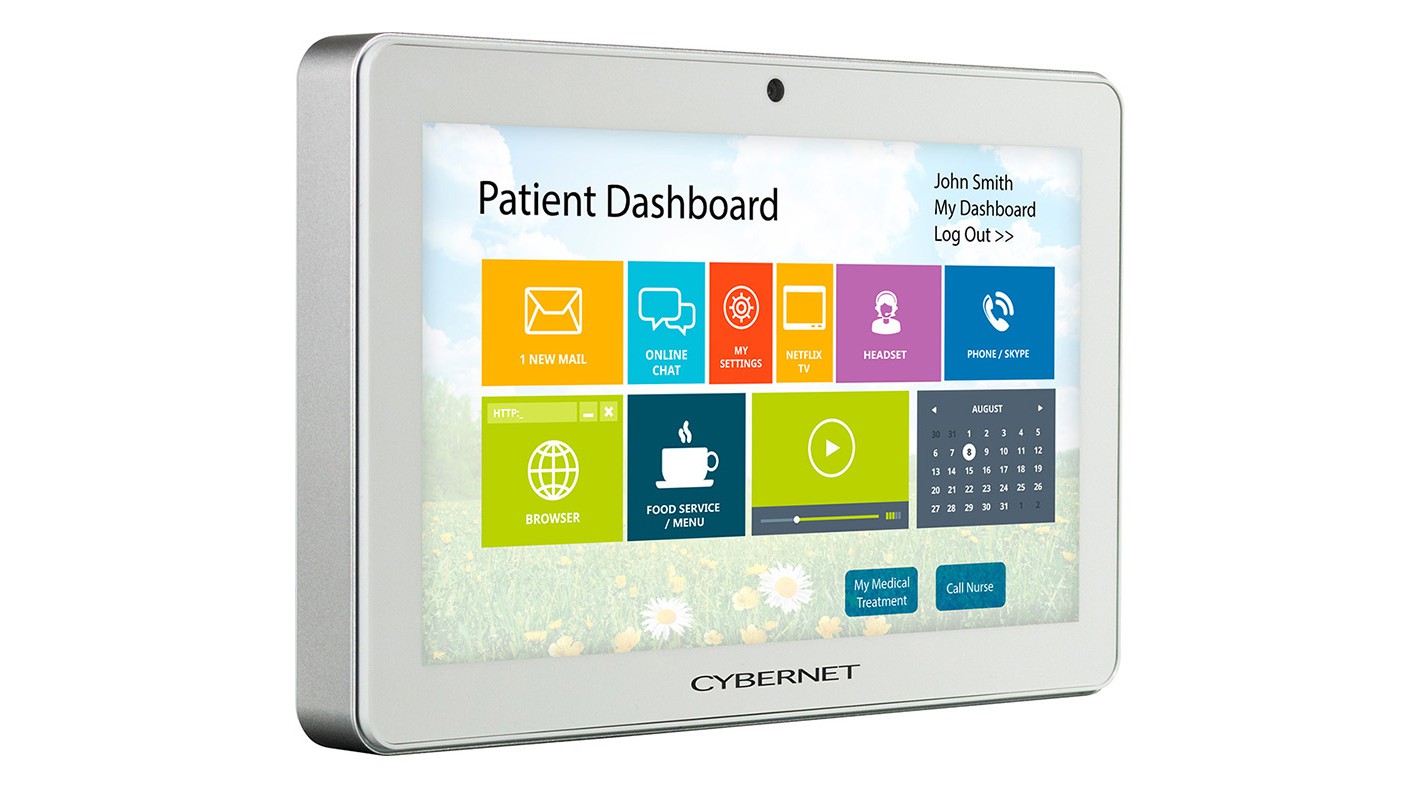The value-based healthcare system becomes more competitive than ever, and hospitals need to focus on the patient experience as one of the main contributing factors to how patients evaluate their stay. As Medicare reimbursement now directly depends on patient satisfaction, hospitals focus on boosting their Hospital Consumer Assessment of Healthcare Providers and Systems score, HCAHPS. It is this pursuit of the HCAHPS score that urges medical facilities to adopt a patient-centric approach. The patient infotainment and engagement systems have proven to be effective in increasing patient satisfaction, HCAHPS scores, and building loyalty.
When implemented efficiently, patient infotainment systems serve multiple purposes, for both patients and medical professionals. Here is a brief list of things to consider before you choose the medical bedside computers or medical tablets for your patient infotainment systems.
Key Considerations
Article Guide
Goals.
Determine what your goals you can achieve by deploying an All-in-One patient entertainment point-of-care system:
- increase patient satisfaction
- increase clinician productivity
- use a single device for multiple purposes
- replace multiple pieces of equipment with a single computer or tablet
Potential for hardware upgrades.
Define what upgrades for the medical computers, on the software and the hardware level, you might need to request from the provider. Inquire whether they can provide the corresponding support.
Infrastructure capacity.
Define what upgrade requirements the infotainment system imposes on your existing infrastructure and network. New cabling, new furniture, more bandwidth, etc. Can you minimize the footprint?
Integration.
Decide whether to integrate the bedside medical computers with your clinical applications. The benefits of integrating are numerous – your staff is more productive, the patient tracking is more streamlined, with fewer errors, the complete record of all episodes of care, etc. If you deploy a medical grade computer at the patient bedside, why not harness its full potential?
Identify the most valuable features/apps a patient infotainment system can offer to:
- Your Patients
- Communication – browser, chat, email, teleconferencing, quick nurse call button, a way to contact the doctor, front-facing webcam.
- Entertainment – patients should be able to order meals, access their subscription services like Netflix, and have access to YouTube, games, music, radio, news.
- Productivity – calendar, personal email, notes, MS Office, easy way to access personal health record, secure way to process online financial transactions, complete online forms, control the lights, room temperature, window covers, bed. Consider installing a translation app and a voice recognition software for patients with limited physical ability to control the computer with voice commands.
- Education – interactive presentations, educational games that increase patient awareness on their condition, symptoms, medication, dietary and lifestyle recommendations
- Your Staff
- EMR for instant access and input if all episodes of care, input patient vitals.
- Order tests, share test results.
- View diagnostic images.
- Use the electronic prescribing system, HELP, PACS and CPOE.
- RFID reader.
- Barcode scanner.
- CAC or SmartCard reader.
- Biometric scanner.
- Secure access to sensitive information.
TCO.
Include several key departments in the decision-making process. Your financial department is likely to favor a known brand and a low purchase price. However, task them with calculating a Total Cost of Ownership of your purchase, taking into account device’s lifespan, ruggedness, failure rates, transmission of nosocomial infections, regulatory compliance. Your legal department will help you make the right choice to remain complaint with the FDA, HIPAA, HITECH and many other regulations that impose specific hardware requirements in patient safety, nosocomial infections, data security, and privacy. Your IT department will provide an even more valuable insight into the TCO of your potential acquisition. They will assess the deployment and maintenance expenses, compatibility with your enterprise software and medical equipment, disk imaging and customization possibilities, and explain how overall failure rates translate into either downtime/expenses or reliability/benefits.
Hardware.
Depending on your requirements and budget, you can customize the build of your infotainment system, be it a medical computer or tablet.
- Do you intend to mount it on a wall, desktop, moving arm – VESA mounting is a welcome feature.
- Wired or wireless – the latter is more ergonomic.
- Does it need serial ports to support legacy equipment?
- What operating system, RAM, processor, video card, storage do you need?
- Do you need sandboxing capability?
- Large-screen high-resolution medical computer or compact medical grade tablet?
- Easy-to-use touchscreen is ergonomic as opposed to a solution that required external keyboard and mouse.
Compliance.
Unlike consumer TVs and computers, bedside infotainment devices like a medical-grade computer must meet strict standards of patient safety and durability. A sturdy, waterproof IP65 casing allows for disinfection with liquid chemicals. Medical grade computer or tablet supports your infection control objectives.
MIL-STD certified components ensure compliance with safety standards and prevent harm to patients. For post-operation infection control, consider a fanless design that prevents germ circulation and is near-silent.
Customizations, warranties.
When selecting a provider, consider manufacturer vs vendor, as the former is more flexible in providing necessary customizations (include legacy ports, embedded scanners/readers, free disk imaging, more RAM, storage, etc.) and offer extended warranties and out of warranty service.
Benefits
- Patient bedside computers serve dual purposes and cater to the patients and the doctors.
- All-in-One medical computers or medical grade tablets used as patient infotainment systems combine multiple tools in a single build – computer, TV, telephone, nurse call button, remote control for TV, curtains, beds, lights, communication terminal.
- Easy mounting with standard VESA holes enables an ergonomic integration into the existing design of the patient rooms without any critical system upgrades or remodeling.
- Models with hot-swap batteries or internal backup UPS are ergonomic and eliminate the extra wire clutter, which is unwelcome in patient rooms.
- AIO medical grade computers or medical grade tablets come integrated with a plethora of peripherals – barcode reader, RFID scanner, biometric reader, CAC, Smart Card reader. This enables secure user authentication, reliable data protection and enables integration and control of IoT devices.
- Antimicrobial* properties protect the computer casing from deterioration and degradation.
Progress Enabler
Bedside infotainment systems offer a host of education, entertainment, communication, engagement options for patients in an interactive, customized manner. Medical point-of-care computers easily combine bedside entertainment systems with clinical applications, becoming an indispensable tool for clinicians, nurses and other caregivers. Patient infotainment/engagement improves patient satisfaction, patient safety, doctor productivity, and quality outcomes.
As hospitals recognize the positive effect of infotainment on patient satisfaction, and bedside medical AIOs for clinician productivity, these versatile patient-doctor systems become the new norm.
Patient Infotainment – The Benefits of Utilizing Bedside Computers
February 25, 2016
We as a thinking species have evolved in more complex ways than one. In terms of our understanding and accepted definitions of technology, for instance. In the new globalized lives we lead today, ‘medicine’ has evolved…
0 Comments4 Minutes
3 Ways Patient Infotainment is Improving Patient Health
October 23, 2017
Credence Research, a worldwide market research and counseling firm, reports that increasing demands across the US, UK, and other nations for patient infotainment systems have prompted large investments from hospitals,…
0 Comments6 Minutes
You Can't
Learn from a Pop-up
But we can deliver knowledge to your inbox!
We dive deep in the industry looking for new trends, technology, news, and updates. We're happy to share them with you.
Knowledge, News, and Industry Updates Right in Your Inbox




